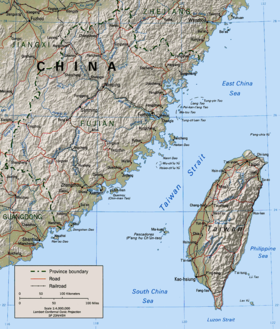| First Taiwan Strait Crisis | |||||||
|---|---|---|---|---|---|---|---|
| Part of the Cold War and the aftermath of the Chinese Civil War | |||||||
 Taiwan Strait | |||||||
| |||||||
| Belligerents | |||||||
|
|
| ||||||
| Commanders and leaders | |||||||
|
|
| ||||||
| Casualties and losses | |||||||
|
|
| ||||||
The First Taiwan Strait Crisis (also known as the Formosa Crisis, the 1954–1955 Taiwan Strait Crisis, the Offshore Islands Crisis, the Quemoy-Matsu Crisis, and the 1955 Taiwan Strait Crisis) was a brief armed conflict between the People's Republic of China (PRC) and the Republic of China (ROC) focused on several ROC-held islands a few miles from the Chinese mainland in the Taiwan Strait.
The crisis began when the PRC initiated heavy bombardment of Kinmen (Quemoy) island in September 1954. Shelling was subsequently extended to the Matsu and Tachen (Dachen) islands. In response, the United States and the ROC agreed to the Sino-American Mutual Defense Treaty in December 1954. In January 1955, the PRC seized the Yijiangshan Islands. Later that month, the Formosa Resolution was approved by both houses of the U.S. Congress, authorizing President Dwight D. Eisenhower to defend the ROC and its possessions. The U.S. Navy helped ROC troops evacuate from the Tachen Islands.
The crisis de-escalated in April 1955 after Premier Zhou Enlai articulated the PRC's intention to negotiate with the United States at the Bandung Conference, and in May 1955 the People's Liberation Army ceased shelling Kinmen and Matsu. Ambassadorial-level discussions between China and the U.S. began in Geneva in August 1955. The fundamental issues of the conflict remained unresolved, which led to another crisis three years later.
- ^ a b Han Cheung (12 January 2020). "Taiwan in Time: Yijiangshan: Moving the Americans to action?". Taipei Times. Retrieved 14 January 2020.
- ^ Cite error: The named reference
Taipei Timeswas invoked but never defined (see the help page).